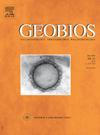Early Pleistocene (Epivillafranchian) vertebrates from Portugal: An updated review
IF 1.6
4区 地球科学
Q2 PALEONTOLOGY
引用次数: 0
Abstract
The Epivillafranchian (1.2 to 0.8 Ma) fossil vertebrate assemblages of Portugal are extremely poorly known compared with to those from the eastern half of Iberia. We review material from one of the two localities of this age previously known in Portugal, Algoz, and present a new microvertebrate locality, Santa Margarida. Both localities are situated in Algarve (South Portugal). The fauna of Algoz includes Hippopotamus antiquus, Eucladoceros sp., Metacervocerus rhenanus and an indeterminate leporid. There are remains of at least two individuals of each deer species from Algoz, although most of the remains are from the same juvenile individual of Eucladoceros sp., about 6 months old. The age of Algoz is determined to be ∼1.2 Ma given the combination of species and their biometrical and morphological characters. Santa Margarida has at least ten species of microvertebrates: Lacertidae indet., Crocidura sp., Sorex sp., Oryctolagus cf. cuniculus, Eliomys cf. quercinus, Apodemus cf. sylvaticus, Allocricetus bursae, Victoriamys chalinei, Iberomys huescarensis, and Iberomys brecciensis. This is the first occurrence of Victoriamys chalinei and Iberomys huescarensis –two vole species typical from the Early Pleistocene – in Portugal. Santa Margarida is younger than Algoz, ranging between ∼0.9 and ∼0.6 Ma, which means that the Early-Middle Pleistocene transition could be represented by this locality.
葡萄牙早更新世(Epivillafranchian)脊椎动物:最新综述
与伊比利亚东半部相比,葡萄牙的Epivillafranchian(1.2至0.8 Ma)化石脊椎动物组合极为鲜为人知。我们回顾了这个时代在葡萄牙已知的两个地点之一的材料,阿尔戈兹,并提出了一个新的微脊椎动物地点,圣玛格丽达。这两个地方都位于阿尔加维(葡萄牙南部)。阿尔戈兹的动物群包括古河马、Eucladoceros sp.、meacervocerus rhenanus和一种不确定的lepora。在阿尔戈兹,每个鹿种至少有两个个体的遗骸,尽管大多数遗骸来自于大约6个月大的Eucladoceros sp.的同一幼年个体。根据物种组合及其生物特征和形态特征,确定Algoz的年龄为~ 1.2 Ma。圣玛格丽达至少有十种微型脊椎动物:乳虫科。、长尾鳄、长尾鳄、长尾鳄、长尾鳄、森林姬鼠、布氏白腹鳄、白尾鳄、黑尾鳄、白尾鳄。这是葡萄牙首次发现早更新世典型的两种田鼠——维多利亚鼠(Victoriamys chalinei)和伊比利亚鼠(Iberomys huescarensis)。Santa Margarida比Algoz更年轻,在~ 0.9 ~ ~ 0.6 Ma之间,这意味着该地区可以代表早-中更新世的转变。
本文章由计算机程序翻译,如有差异,请以英文原文为准。
求助全文
约1分钟内获得全文
求助全文
来源期刊

Geobios
地学-古生物学
CiteScore
3.30
自引率
6.20%
发文量
28
审稿时长
6-12 weeks
期刊介绍:
Geobios publishes bimonthly in English original peer-reviewed articles of international interest in any area of paleontology, paleobiology, paleoecology, paleobiogeography, (bio)stratigraphy and biogeochemistry. All taxonomic groups are treated, including microfossils, invertebrates, plants, vertebrates and ichnofossils.
Geobios welcomes descriptive papers based on original material (e.g. large Systematic Paleontology works), as well as more analytically and/or methodologically oriented papers, provided they offer strong and significant biochronological/biostratigraphical, paleobiogeographical, paleobiological and/or phylogenetic new insights and perspectices. A high priority level is given to synchronic and/or diachronic studies based on multi- or inter-disciplinary approaches mixing various fields of Earth and Life Sciences. Works based on extant data are also considered, provided they offer significant insights into geological-time studies.
 求助内容:
求助内容: 应助结果提醒方式:
应助结果提醒方式:


